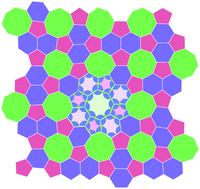当前位置:
X-MOL 学术
›
Soft Matter
›
论文详情
Our official English website, www.x-mol.net, welcomes your feedback! (Note: you will need to create a separate account there.)
Irregular model DNA particles self-assemble into a regular structure†
Soft Matter ( IF 3.4 ) Pub Date : 2017-11-13 00:00:00 , DOI: 10.1039/c7sm01627a Zdeněk Preisler 1, 2, 3, 4 , Barbara Saccà 5, 6, 7, 8 , Stephen Whitelam 1, 2, 3, 4
Soft Matter ( IF 3.4 ) Pub Date : 2017-11-13 00:00:00 , DOI: 10.1039/c7sm01627a Zdeněk Preisler 1, 2, 3, 4 , Barbara Saccà 5, 6, 7, 8 , Stephen Whitelam 1, 2, 3, 4
Affiliation

|
DNA nanoparticles with three-fold coordination have been observed to self-assemble in experiment into a network equivalent to the hexagonal (6.6.6) tiling, and a network equivalent to the 4.8.8 Archimedean tiling. Both networks are built from a single type of vertex. Here we use analytic theory and equilibrium and dynamic simulation to show that a model particle, whose rotational properties lie between those of the vertices of the 6.6.6 and 4.8.8 networks, can self-assemble into a network built from three types of vertex. Important in forming this network is the ability of the particle to rotate when bound, thereby allowing the formation of more than one type of binding motif. The network in question is equivalent to a false tiling, a periodic structure built from irregular polygons, and possesses 40 particles in its unit cell. The emergence of this complex structure, whose symmetry properties are not obviously related to those of its constituent particles, highlights the potential for creating new structures from simple variants of existing nanoparticles.
中文翻译:

不规则模型DNA粒子自组装成规则结构†
在实验中,观察到具有三重配位的DNA纳米粒子自组装成相当于六边形(6.6.6)拼贴的网络和相当于4.8.8阿基米德拼贴的网络。这两个网络都是从单一类型的顶点构建的。在这里,我们使用解析理论,平衡和动态模拟来显示模型粒子,其旋转属性位于6.6.6和4.8.8网络的顶点之间,可以自组装为由三个顶点类型。形成该网络时重要的是粒子在结合时旋转的能力,从而可以形成一种以上的结合基序。所讨论的网络等效于错误的平铺,这是一种由不规则多边形构成的周期性结构,在其晶胞中拥有40个粒子。这种复杂结构的出现,其对称性与其组成颗粒的对称性没有明显关系,这突出了从现有纳米颗粒的简单变体创建新结构的潜力。
更新日期:2017-11-13
中文翻译:

不规则模型DNA粒子自组装成规则结构†
在实验中,观察到具有三重配位的DNA纳米粒子自组装成相当于六边形(6.6.6)拼贴的网络和相当于4.8.8阿基米德拼贴的网络。这两个网络都是从单一类型的顶点构建的。在这里,我们使用解析理论,平衡和动态模拟来显示模型粒子,其旋转属性位于6.6.6和4.8.8网络的顶点之间,可以自组装为由三个顶点类型。形成该网络时重要的是粒子在结合时旋转的能力,从而可以形成一种以上的结合基序。所讨论的网络等效于错误的平铺,这是一种由不规则多边形构成的周期性结构,在其晶胞中拥有40个粒子。这种复杂结构的出现,其对称性与其组成颗粒的对称性没有明显关系,这突出了从现有纳米颗粒的简单变体创建新结构的潜力。


























 京公网安备 11010802027423号
京公网安备 11010802027423号